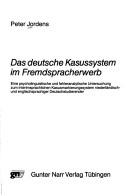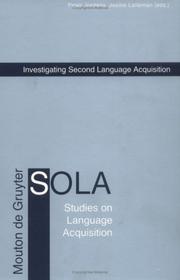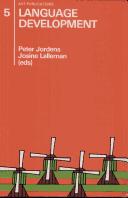| Listing 1 - 10 of 30 | << page >> |
Sort by
|

ISBN: 3878082568 9783878082569 Year: 1983 Volume: 6 Publisher: Tübingen: Narr,
Abstract | Keywords | Export | Availability | Bookmark
 Loading...
Loading...Choose an application
- Reference Manager
- EndNote
- RefWorks (Direct export to RefWorks)
Didactics of German --- German language --- Dutch language --- English language --- Case --- Study and teaching --- Dutch speakers --- English speakers --- Grammar, Comparative --- Dutch --- German --- English --- German. --- Case. --- Dutch. --- English. --- Dutch speakers. --- English speakers. --- German language - Case --- German language - Study and teaching - Dutch speakers --- German language - Study and teaching - English speakers --- German language - Grammar, Comparative - Dutch --- Dutch language - Grammar, Comparative - German --- German language - Grammar, Comparative - English --- English language - Grammar, Comparative - German
Book
ISBN: 3110216205 9783110216202 3110216213 9783110216219 Year: 2012 Publisher: Berlin De Gruyter Mouton
Abstract | Keywords | Export | Availability | Bookmark
 Loading...
Loading...Choose an application
- Reference Manager
- EndNote
- RefWorks (Direct export to RefWorks)
Research on spontaneous language acquisition both in children learning their mother tongue and in adults learning a second language has shown that language development proceeds in a stagewise manner. Learner utterances are accounted for in terms of so-called 'learner languages'. Learner languages of both children and adults are language systems that are initially rather simple. The present monograph shows how these learner languages develop both in child L1 and in adult L2 Dutch. At the initial stage of both L1 and L2 Dutch, learner systems are lexical systems. This means that utterance structure is determined by the lexical projection of a predicate-argument structure, while the functional properties of the target language are absent. At some point in acquisition, this lexical-semantic system develops into a target-like system. With this target-like system, learners have reached a stage at which their language system has the morpho-syntactic features to express the functional properties of finiteness and topicality. Evidence of this is word order variation and the use of linguistic elements such as auxiliaries, tense, and agreement markers and determiners. Looking at this process of language acquisition from a functional point of view, the author focuses on questions such as the following. What is the driving force behind the process that causes learners to give up a simple lexical-semantic system in favour of a functional-pragmatic one? What is the added value of linguistic features such as the morpho-syntactic properties of inflection, word order variation, and definiteness?
Language acquisition. --- Language acquisition --- Languages & Literatures --- Philology & Linguistics --- Psycholinguistics --- Acquisition of language --- Developmental linguistics --- Developmental psycholinguistics --- Language and languages --- Language development in children --- Psycholinguistics, Developmental --- Acquisition --- Interpersonal communication in children --- Finiteness. --- Learner Languages. --- Psycholinguistics. --- Second Language Acquisition.
Book
ISBN: 9789462584778 946258477X Year: 2022 Publisher: Zwolle WBOOKS
Abstract | Keywords | Export | Availability | Bookmark
 Loading...
Loading...Choose an application
- Reference Manager
- EndNote
- RefWorks (Direct export to RefWorks)
Boekdrukker en kunstenaar Hendrik Nicolaas Werkman (1882-1945) was prominent lid van de Groninger kunstkring De Ploeg. Begin jaren 20 van de vorige eeuw kwam hij op het idee om met het materiaal dat hij als drukker in handen had, kunst te gaan maken. Zijn vernieuwende omgang met het rigide materiaal van de drukker, brak met de dan geldende regels. Iets wat hij zijn hele kunstenaarsleven lang zou blijven doen. Werkman gebruikte letters, cijfers en tekens, vlakken en lijnen en ook de inktrol om grafische werken te maken die hij druksels noemde. Zijn onconventionele manier van werken ontwikkelde hij al doende. De artistieke mogelijkheden van zijn drukseltechniek vormt een bron van inspiratie. Destijds voor zijn medekunstenaars van De Ploeg en tijdgenoten, maar ook vandaag de dag voor toonaangevende kunstenaars in binnen- en buitenland. Het boek Hendrik Werkman, het druksel en de kunst toont Werkman als een van de grote Nederlandse kunstenaars van de 20ste eeuw. Een grafisch kunstenaar die zichzelf bleef vernieuwen. Letters en cijfers toonden zich tot dan toe nog nooit zo eigenzinnig aan de wereld. Veel van Werkmans artistieke drukwerk is bewaard gebleven. Wat kunstenaars en liefhebbers zo aantrekt in Werkmans unieke druksels, is zijn ambachtelijke manier van werken en persoonlijke betrokkenheid. Zijn ‘humane’ werkwijze is wat de druksels onderscheidt van het aan het Oost-Europese constructivisme gelieerde oeuvre van Werkmans tijdgenoot, de architect en vormgever Piet Zwart. Hedendaagse Nederlandse kunstenaars als Ewald Spieker, Ben Joosten en Harry Wolfkamp laten in Hendrik Werkman, het druksel en de kunst zien hoe zij zich met hun fascinatie voor de kracht van letters door Werkman hebben laten inspireren. --WBOOKS
655.262 <492> --- 655.262 <492> Boekdesign--algemeen--Nederland --- 655.262 <492> Typographic design of the text. Aesthetic questions, text division and layout, arrangement of illustrations etc.--Nederland --- Boekdesign--algemeen--Nederland --- Typographic design of the text. Aesthetic questions, text division and layout, arrangement of illustrations etc.--Nederland --- Graphic arts --- color lithographs --- monotypes [planographic prints] --- printmaking --- boekdrukkunst --- Werkman, Hendrik
Book
Year: 1985 Publisher: Brussel VUB
Abstract | Keywords | Export | Availability | Bookmark
 Loading...
Loading...Choose an application
- Reference Manager
- EndNote
- RefWorks (Direct export to RefWorks)
Book
ISBN: 9789462582286 Year: 2017 Publisher: Zwolle Wbooks
Abstract | Keywords | Export | Availability | Bookmark
 Loading...
Loading...Choose an application
- Reference Manager
- EndNote
- RefWorks (Direct export to RefWorks)
Art styles --- Constructivist --- Werkman, Hendrik
Digital
ISBN: 9783110216219 9783110216202 Year: 2012 Publisher: Berlin ;; Boston De Gruyter Mouton
Abstract | Keywords | Export | Availability | Bookmark
 Loading...
Loading...Choose an application
- Reference Manager
- EndNote
- RefWorks (Direct export to RefWorks)
Book
ISBN: 1282456873 9786612456879 3110216175 9783110216172 9783110216165 3110216167 9781282456877 Year: 2009 Publisher: Berlin New York Mouton de Gruyter
Abstract | Keywords | Export | Availability | Bookmark
 Loading...
Loading...Choose an application
- Reference Manager
- EndNote
- RefWorks (Direct export to RefWorks)
Language acquisition is a developmental process. Research on spontaneous processes of both children learning their mother tongue and adults learning a second language has shown that particular stages of acquisition can be discriminated. Initially, learner utterances can be accounted for in terms of a language system that is relatively simple. In studies on second language acquisition this learner system is called the Basic Variety (Klein and Perdue 1997). Utterance structure of the Basic Variety is determined by a grammar which consists of lexical structures that are constrained, for example, by semantic principles such as "The NP-referent with highest control comes first" and a pragmatic principle such as "Focus expression last". At some point in acquisition this lexical-semantic system is given up in favour of a target-like system with morpho-syntactic features to express the functional properties of finiteness, topicality, the determiner system, etc. Insights into how this process evolves may also provide an answer to the question of why it takes place. Within this functional perspective on language acquisition research focuses on questions such as the following.1. What is the driving force behind the process that causes learners to give up a simple lexical-semantic system in favour of a morpho-syntactic functional category system?2. What is the added value of morpho-syntactic properties of inflection, word-order variation, definiteness and agreement?3. Why is it that in cases of specific language impairment it is mainly morpho-syntactic properties of the target language that are affected?
Language acquisition. --- Second language acquisition. --- Second language learning --- Language acquisition --- Acquisition of language --- Developmental linguistics --- Developmental psycholinguistics --- Language and languages --- Language development in children --- Psycholinguistics, Developmental --- Interpersonal communication in children --- Psycholinguistics --- Acquisition --- Grammaticalization. --- Language Acquisition. --- Second Language Acquisition.
Book
Year: 1992 Publisher: Amsterdam : Vrije universiteit Amsterdam. Department of applied linguistics,
Abstract | Keywords | Export | Availability | Bookmark
 Loading...
Loading...Choose an application
- Reference Manager
- EndNote
- RefWorks (Direct export to RefWorks)

ISBN: 3110151502 1306275806 3110812835 9783110812831 9783110151503 Year: 1996 Volume: 12 Publisher: Berlin New York Mouton de Gruyter
Abstract | Keywords | Export | Availability | Bookmark
 Loading...
Loading...Choose an application
- Reference Manager
- EndNote
- RefWorks (Direct export to RefWorks)
The book concerns theoretical, interdisciplinary and methodological issues in L2 acquisition research. It gives an accurate and up-to-date overview of high quality work currently in progress in research methodology, processing, principles and parameters theory, phonology, the bilingual lexicon, input and instruction. The volume will have the purpose of a handbook for teachers, students and researchers in the area of second language acquisition. The aim is to provide the reader with an acquisition perspective on processes of second and foreign language learning.
Second language acquisition. --- Psycholinguistics --- Second language acquisition --- Langue seconde --- Acquisition --- Second language learning --- Language acquisition

ISBN: 9067654019 9789067654012 Year: 1988 Volume: 5 Publisher: Dordrecht: Foris,
Abstract | Keywords | Export | Availability | Bookmark
 Loading...
Loading...Choose an application
- Reference Manager
- EndNote
- RefWorks (Direct export to RefWorks)
| Listing 1 - 10 of 30 | << page >> |
Sort by
|

 Search
Search Feedback
Feedback About UniCat
About UniCat  Help
Help News
News